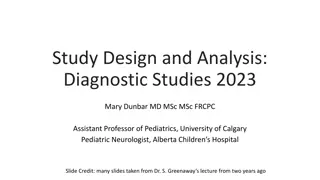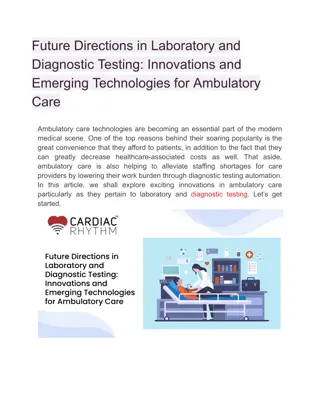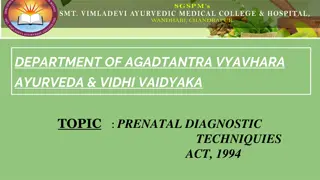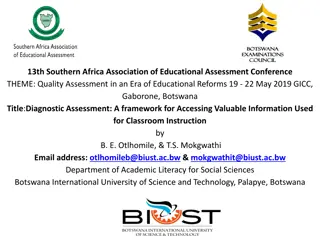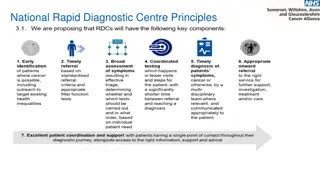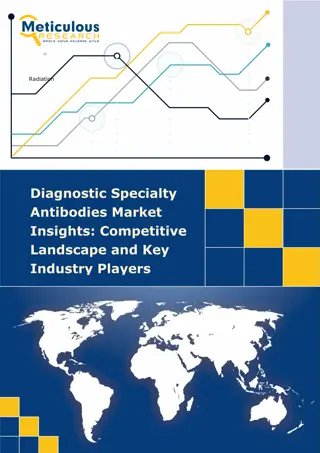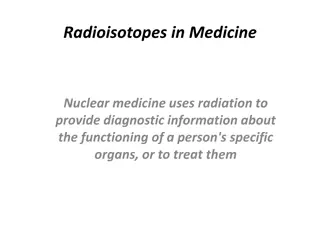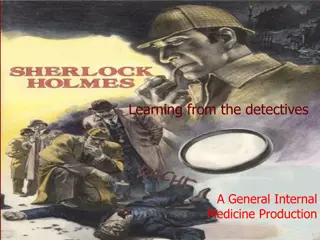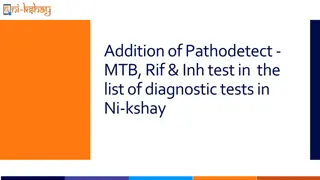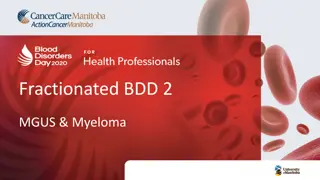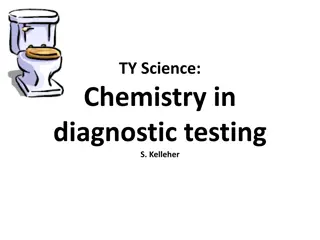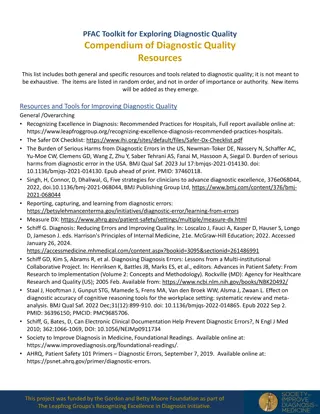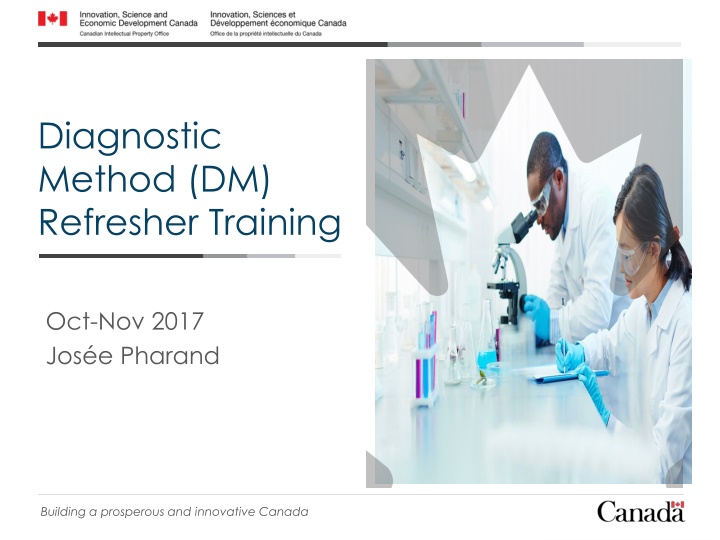
Innovative Diagnostic Method Training & Practice Insights
Explore insights from the Diagnostic Method Refresher Training and Practice at the University of Calgary, focusing on key aspects like data acquisition, analysis, and claim examples. Enhance your understanding of creating diagnostic methods effectively.
Download Presentation

Please find below an Image/Link to download the presentation.
The content on the website is provided AS IS for your information and personal use only. It may not be sold, licensed, or shared on other websites without obtaining consent from the author. If you encounter any issues during the download, it is possible that the publisher has removed the file from their server.
You are allowed to download the files provided on this website for personal or commercial use, subject to the condition that they are used lawfully. All files are the property of their respective owners.
The content on the website is provided AS IS for your information and personal use only. It may not be sold, licensed, or shared on other websites without obtaining consent from the author.
E N D
Presentation Transcript
Diagnostic Method (DM) Refresher Training Oct-Nov 2017 Jos e Pharand Riley Brandt, University of Calgary Building a prosperous and innovative Canada
Diagnostic Method Practice Established following the 2011 Amazon FCA decision Initially set out in PN 2015-02, published in June 2015 (soon to be published as part of MOPOP Chapter 17) Refresher training prepared with input from the DM Experts Group 2
Refresher Training Slides on various topics, not complete review Focus on lessons learned and sticking points General PCon refresher to follow later Today - slides Discussion of two case files to follow Afterwards, distribution of DM examples and additional session 3
Diagnostic Methods From PN 2015-02: The POSITA will read the specification in the expectation that it sets out something beyond commonly known solutions to commonly known problems An application may describe more than one problem Recognizing that how data is analyzed in a DM generally has no material effect on how the data needs to be physically acquired (and vice versa), the data acquisition elements and data analysis elements in the DM likely = aggregation 4
Purposive Construction POSITA ? POSITA=Person of ordinary skill in the art CGK=Common general knowledge CGK ? Problem ? Solution ? If at least one EE is statutory, claim is considered statutory, unless one EE is an exclusion Essential Elements (EEs) ? Are EEs statutory ? (complies with section 2): 5
Diagnostic methods Two aspects/Two potential problems: Data acquisition Data analysis Correlate Measure 6
Claim Example Claim 1 A method of diagnosing disorder X by: a) detecting the presence of marker Y using steps ABC, and b) correlating the presence of Y with disorder X. 7
How to do it practically? Examination can first focus on the problem that is more likely to lead to a patentable invention The data acquisition problem solution will be statutory; if it s novel and non-obvious no need to discuss data analysis If data acquisition is obvious use a strategic approach It is possible that neither of the two solutions will be patentable 8
Required vs Essential The term required should not be used in DM reports to describe the elements of the alternate problem If you re focusing on the data analysis problem, the elements of the data acquisition are NOT required but non-essential and vice-versa Remember the aggregative nature of these claims 9
Prior Art vs CGK Prior art: knowledge disclosed before the claim date (usually in a document) CGK: knowledge POSITA already has (no need to look it up) Determine the problem-solution based on CGK ONLY Prior Art or CGK? EB 2015-P9-H 10
Topics to follow Screening method or DM? Combination of markers SNPS and gene sequences in databases Comprising vs consisting Obviousness New patient populations Impasse? 11
Screening/Measuring Methods Screening methods or measuring methods generally feature practical steps that provide information They include methods of determining the presence/absence of a substance, of measuring an attribute or of identifying a substance that has a particular property When a claim is determined to be a screening or measuring method, the DM practice should not be applied 12
Screening/Measuring Methods vs DMs Typically, a DM claim will include a further step where a correlation is made from the information This is not a strict rule however a claim may have an if/then statement and not be a DM For example a screening method claim may end with a step indicating that if a fluorescence is observed, then select the target It is important to always perform a Pcon 13
Screening/Measuring Methods vs DMs There will be claims that fall in a grey area Claim preambles can be misleading: A method for screening comprising analyzing a sample for compound X wherein if X is present the sample is from a subject having disease Y. It is valuable in these cases to consider Pcon as if the method is a screening method and another as if the method is a DM to see if and how your conclusions would differ (but don t put both in a report) 14
Combination of markers Claim includes data acquisition step(s) for measuring or detecting at least two markers in combination e.g, method for predicting Y comprising measuring the expression levels of genes A, B and C, wherein Y is likely if A, B and C are increased relative to the levels of A, B and C in a healthy control 15
Combination of markers Note - where multiple markers are recited but only a single marker is actually measured or detected, the claim does not recite a combination of markers and this guidance is not relevant e.g, method for predicting Y comprising measuring the expression level of a gene selected from A, B and C, wherein Y is likely if A, B or C is increased relative to Novel marker in the combination Data acquisition problem likely solved Claim will be novel and statutory* 16
Combination of markers Each markers is CGK and/or in the prior art It is still possible that a data acquisition problem was solved, must consider: (A)whether a means for measuring all of the markers together was CGK (B)whether it was CGK to specifically acquire data about those markers (and disregard data about all other markers) a data acquisition problem is likely solved where at least one of (A) and (B) was not CGK, however, the claim may still be anticipated or obvious 17
Combination of markers When determining the problem/solution, it is improper to base the conclusion on whether it would have been obvious to the POSITA how to detect or measure each of the (novel or known) markers individually or whether it would have been obvious to detect or measure the markers in combination Could be obvious but not CGK to combine them, in which case still data acquisition Could be obvious AND CGK to combine them, in which case data analysis 18
SNPs and Gene sequences in databases Disclosure of SNP or gene sequence in a database (e.g. dbSNP, Refseq) not sufficient to conclude SNP or sequence and detection thereof are CGK. Further, it cannot necessarily be concluded that such a disclosure inherently describes and enables data acquisition steps of detecting that specific SNP or sequence e.g. in a patient sample. A database does not teach looking specifically at particular genes or SNPs (or a subset thereof). 19
SNPs and Gene sequences in databases (continued) Disclosure of SNP or gene sequence in a database (e.g. dbSNP, Refseq)ALSO not sufficient to conclude SNP or sequence and detection thereof are obvious The mere existence of a database does not imply that the concept of specifically acquiring data about a particular SNP or sequence (or subset of SNPs or sequences) would be obvious Obviousness of data acquisition steps will depend on the fact situation 20
Comprising vs. Consisting Considerascenario in which a commercially available microarray contains probes to 38,000 human genes, including O, M and T, and where measuring the gene expression levels of O,M and T together in combination was not CGK. Claims 1. A method of predicting survival of a patient having disease X comprising: (a) measuring expression levels of genes O, M and T in a patient s sample; (b) Wherein [correlation]. 2. A microarray comprising probes to genes O, M and T. 3. A microarray consisting of probes to genes O, M and T. 21
Comprising vs. Consisting 1. A method of predicting survival of a patient having disease X comprising: (a) measuring expression levels of genes O, M and T in a patient s sample; (b) Wherein [correlation]. Each of genes O,M and T were represented amongst thousands of other genes on a single commercial microarray It was not CGK however to both -specifically measure the expression levels of genes O,M and T and -specifically acquire the data about the expression levels of O,M and T (while disregarding levels of all other genes) 22
Comprising vs. Consisting 2. A microarray comprising probes to genes O, M and T. 3. A microarray consisting of probes to genes O, M and T. Claim 2 is anticipated by the commercially available microarray Claim 3 is not anticipated by the commercially available microarray Note that claim 1 doesn t have to specify a particular method of measuring gene expression levels it is not CGK to measure that specific combination of gene expression levels, therefore there is a data acquisition problem and the claim is statutory The applicant could have claimed any method of measuring that combination of gene levels, including using the commercial microarray Obviousness still has to be assessed based on the prior art 23
Obviousness Is determined on a claim-by-claim basis after the claims have been purposively construed Follows Sanofi 4-step approach and considers the Inventive Concept of the claim, where the IC is related to the problem to be solved In most cases, the IC relates to the essential elements of the claim Where the examiner has concluded there is a data acquisition problem, no data analysis elements will be part of the IC (and vice versa) 24
Obviousness Inventive concept Prior Art Obvious Determining presence of protein X in tumor tissue from liver sample Detected presence of protein X in tumor tissues from breast, colon, prostate, kidney, lung and bone marrow cancers and discovered that X was not detectable in any of the healthy controls. Yes detecting protein X in tumor tissues was well within grasp of POSITA and the POSITA would have been motivated to look for X in liver tumors given that the presence of X appears to correlate to tumor presence. 25
Obviousness Inventive concept Prior Art Obvious Measuring the concentration of compound X in blood. Compared the flammability of eleven commercial fabric sprays and measured the concentration of compound X in each spray. No prior art did not disclose compound X was measured specifically in blood and it would not have been obvious to the POSITA to look for X in blood. 26
New patient population A method of diagnosing Y in patient population Z comprising determining the presence of analyte X in a sample, wherein Y is diagnosed if X is detected. Population Z may represent patients that: have a particular genotype e.g. a mutation in gene A belong to a particular demographic e.g. age, gender experienced a certain disease e.g. have dementia, are in cancer remission received a specific treatment e.g., are receiving hormone therapy, have undergone chemotherapy 27
New patient population The patient population may be relevant to a data acquisition problem/solution. Note, however, this is not true for every claim that refers to a patient population. Consider the following claim: A method of diagnosing disease Y in a patient suspected of having Y comprising measuring marker X 28
New patient population During examination, consider whether the CGK of the POSITA included means for detecting analyte X in a sample from patient population Z. If not CGK, purposively construe as a data acquisition problem. Claim will be statutory* Possibly inherently anticipated or obvious 29
Heading toward an impasse For pre-finals and Final Actions, you must set out the PCon for both problems If you have one document that anticipates the whole claim, you must still set out the PCon for both and anticipate the essential elements of each problem in separate arguments This will assure consistency in the practice 30
DM Experts Chemical Division Cecilia Alperin Isabelle Gagn Cara Weir Biotech Division Katrina Campsall Kerry Ferguson Nicole Harris Sandra Hurley Pascal Lachance Maria Mill Christine Teixeira 31
Acknowledgements I d like to thank the following for their hard work helping to put together this training: Batul Abdulkadir Cecilia Alperin Katrina Campsall Kerry Ferguson Isabelle Gagn Nicole Harris Sandra Hurley Pascal Lachance The GSLF Jeremy McLean Gertrude Major Maria Mill Christine Teixeira Cara Weir 32


